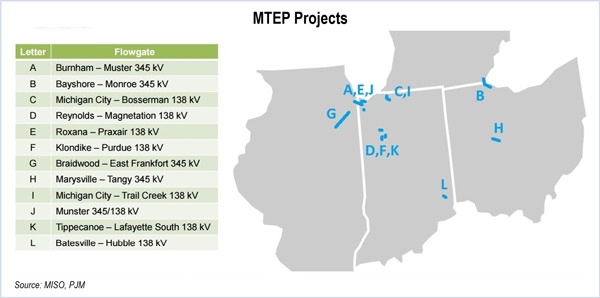By Amanda Durish Cook
MISO and PJM have nearly completed their work on joint operating agreement and tariff language to create the new targeted market efficiency project (TMEP) type, and the RTOs have singled out seven congestion-relieving candidate projects.
Four of the possible TMEPs are located at flowgates in Indiana, while one is in northern Illinois, one is on the southeastern Michigan-Ohio border and another is in central Ohio. The projects, produced from a joint RTO analysis that originally studied 12 candidates, range from 138 kV to 345 kV with total costs of $19 million and benefits of $117 million:
- The Burnham-Munster 345-kV project on the northern Illinois-Indiana border:
- Benefit-cost ratio: $32 million/$6.5 million
- Cost allocation: PJM 88%/MISO 12%
- The Bayshore-Monroe 345-kV project on the southeastern Michigan-Ohio border:
- $17 million/$1 million
- PJM 89%/MISO 11%
- The Michigan City–Bosserman 138-kV project in northern Indiana:
- $29.6 million/$2.3 million
- PJM 90%/MISO 10%
- The Reynolds-Magnetation 138-kV project in north-central Indiana:
- $14.5 million/$150,000
- PJM 41%/MISO 59%
- The Roxana-Praxair 138-kV project in northeastern Indiana:
- $6.5 million/$4.5 million
- PJM 24%/MISO 76%
- The Klondike-Purdue 138-kV project in north-central Indiana:
- $6 million/$4.2 million
- PJM 4%/MISO 96%
- The Marysville-Tangy 345-kV project in central Ohio:
- $12 million/“minimal” cost
- PJM 98%/MISO 2%
“We’re pretty excited about this. This is exactly what we were hoping for,” PJM engineer Alex Worcester said during a Sept. 30 meeting of the MISO-PJM Interregional Planning Stakeholder Advisory Committee (IPSAC). “These aren’t projects that are just squeaking by; these are very significant cost-benefits.”
Worcester also said both RTOs were surprised with how evenly the cost allocation was shared among the total projects.
The RTOs used a joint survey to decide on some details of the TMEP process.
For example, the RTOs will not subtract congestion hedges in calculating project benefits. PJM said not excluding the hedge is “consistent with TMEP goal of simple, efficient metrics easily reproduced by stakeholders.” A majority of 27 survey respondents preferred not to include congestion hedges in the benefit calculation.
Worcester said there’s nothing to prevent congestion hedges being counted in the regional cost allocation, however.
A majority of 22 respondents supported using the last three years of historical congestion data in benefit calculations. Other stakeholders wanted the highest historical congestion data from two of the past three years used, while others wanted the past two years of congestion data used.
Exelon’s Sharon Midgley said the number of respondents seemed “incredibly low.” Worcester said there was “a reasonable cross-section of stakeholders” even though more MISO stakeholders responded than PJM stakeholders.
“This is what we’re going forward with now. In a couple of years from now, we’re open to revisiting this and improving it,” Worcester said.
PJM Manager of Interregional Planning Chuck Liebold said that there are internal RTO cost allocation details that need to be fleshed out in the draft JOA and respective tariff language. “But we have everything we need to know for the interregional benefit calculation and cost allocation,” Liebold said.
PJM and MISO staff said intra-RTO cost allocation rules are being worked out in PJM’s Transmission Owners Agreement-Administrative Committee and MISO’s Regional Expansion Criteria and Benefits Working Group.
MISO’s Adam Solomon said MISO and PJM will file JOA and tariff changes at the same time. In spite of unfinished cost allocation details, the RTOs plan to file the JOA changes sometime in October and recommend project candidates to their boards by December.
A first draft of the JOA language was released at the July IPSAC. (See MISO, PJM Unveil JOA Process for ‘Targeted’ Market Efficiency Projects.)





